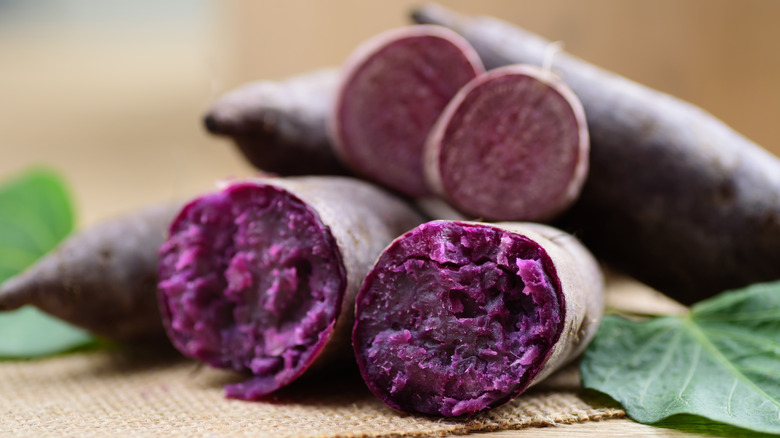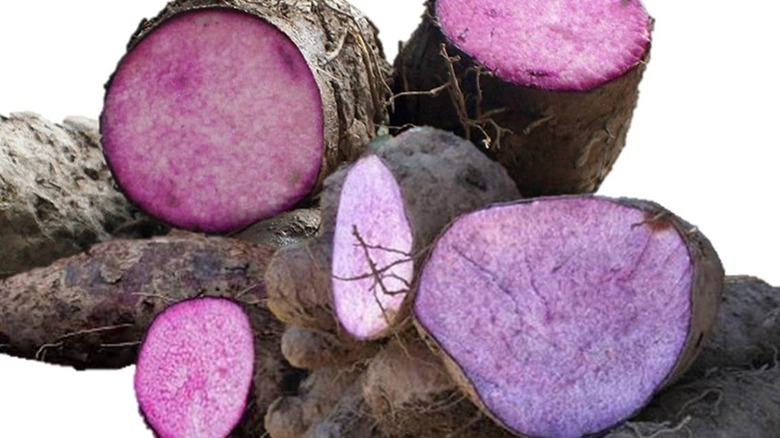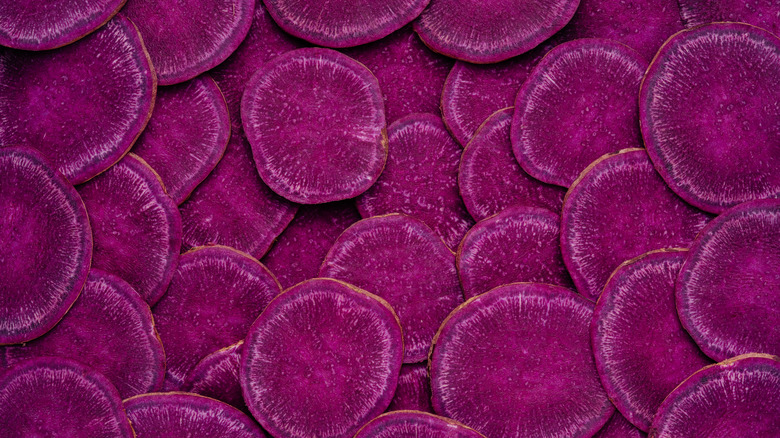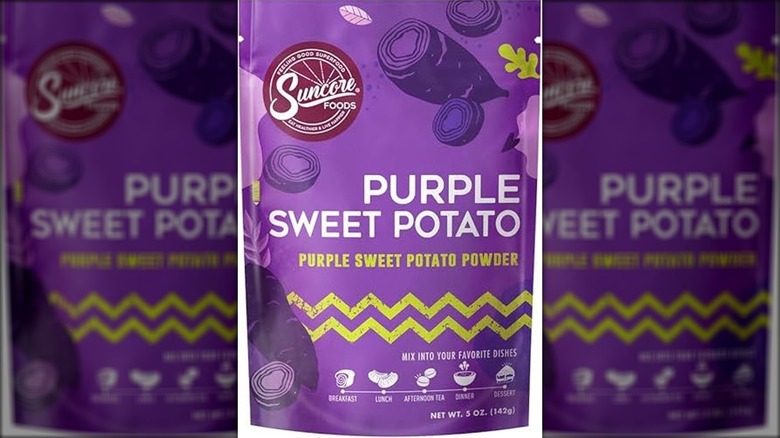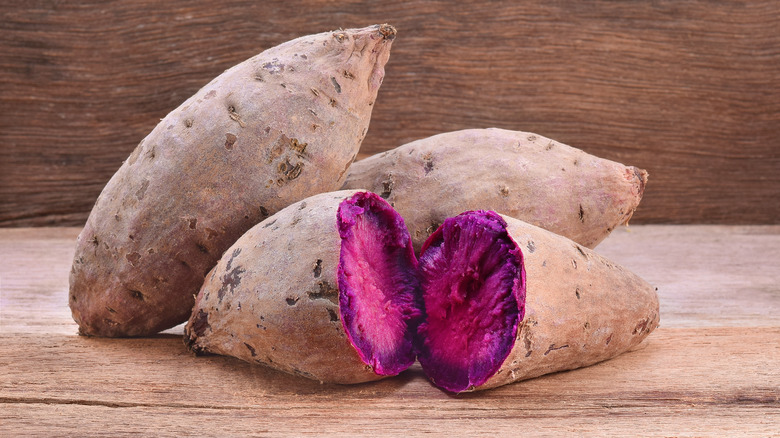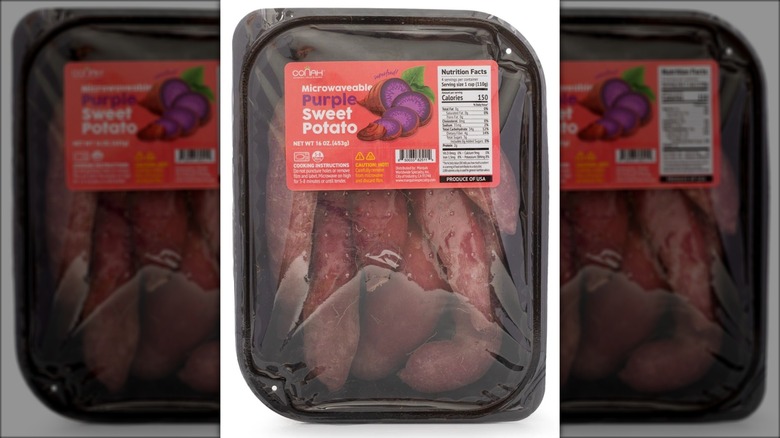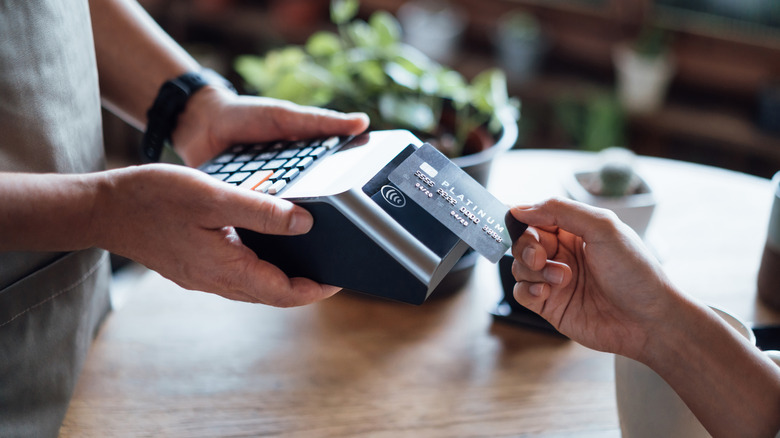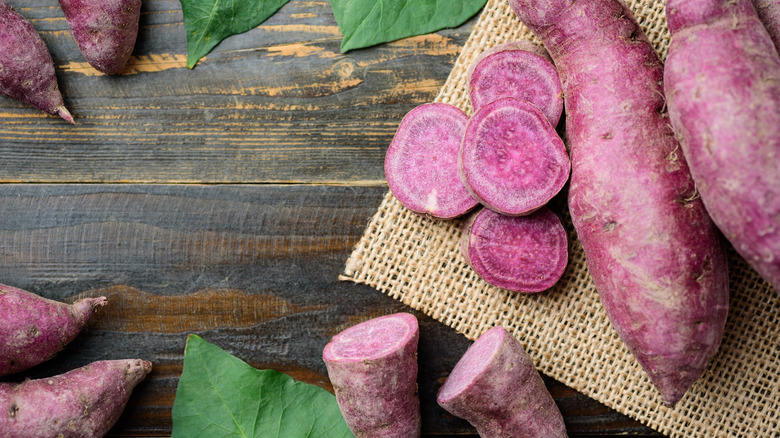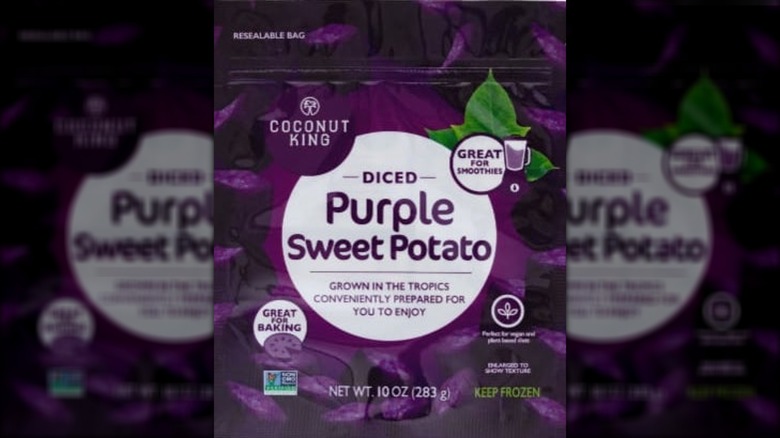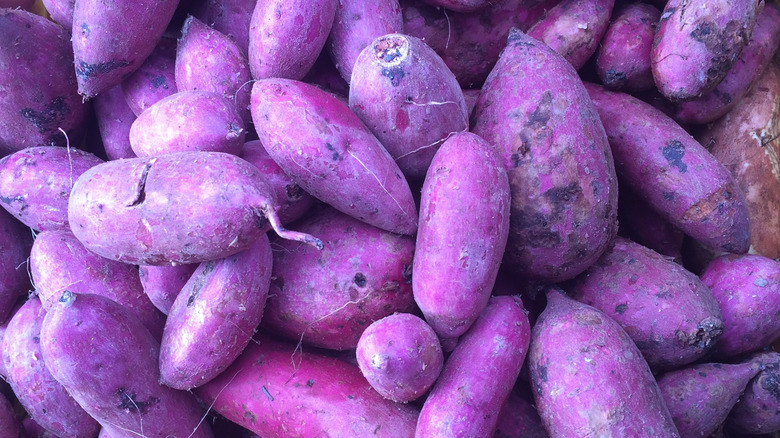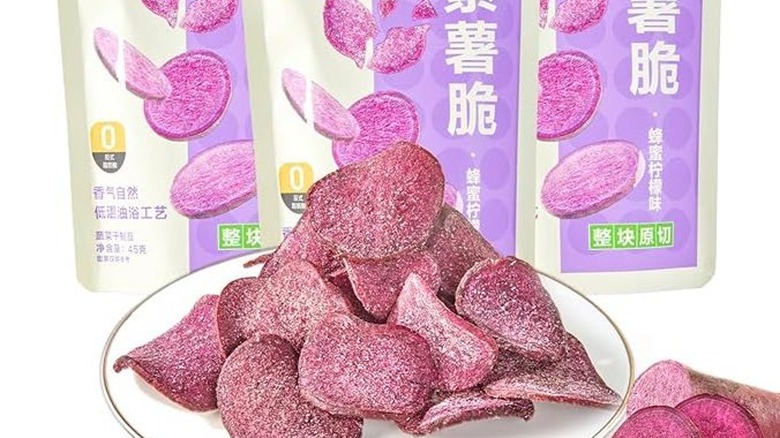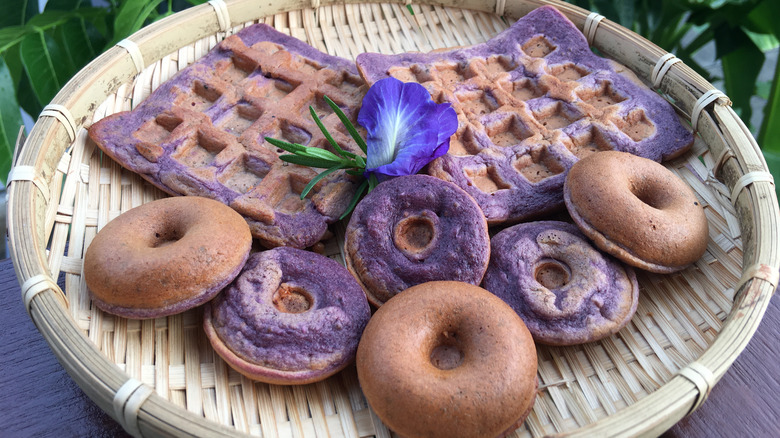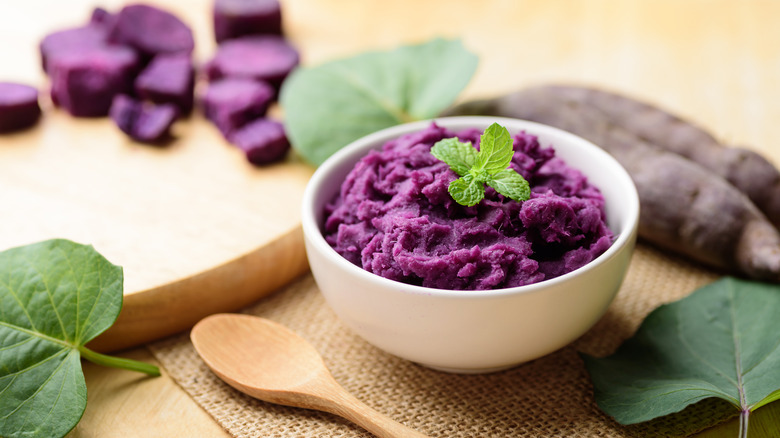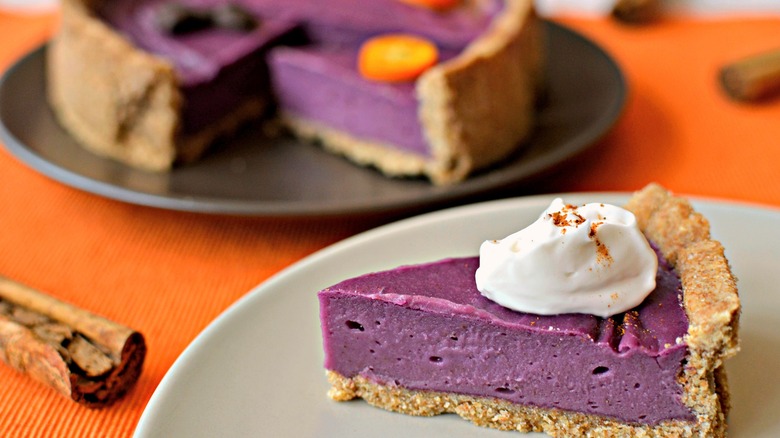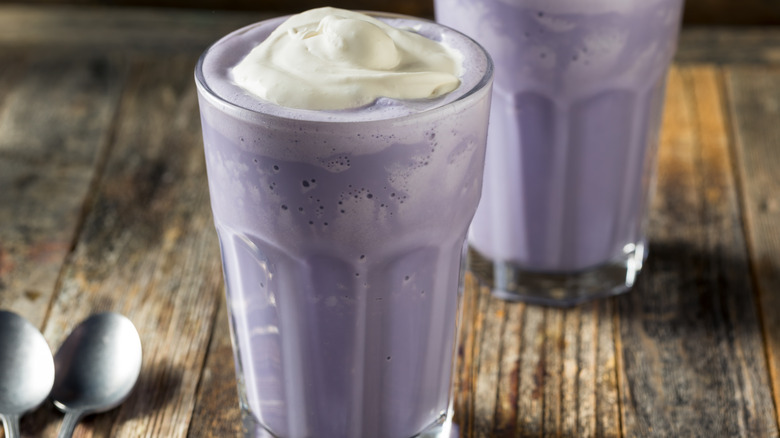What Are Purple Sweet Potatoes And What Are The Best Ways To Cook Them?
We may receive a commission on purchases made from links.
If you've seen purple sweet potatoes popping up a lot lately, you're likely curious about what they taste like and how you can use them. They're actually more versatile than you might think and can be the base for delicious and colorful snacks, desserts, breakfast foods, and savory foods. So, the question is more where you can't use them rather than where you can.
Since they're packed with nutrition and so versatile, you'll want to know where to find them and how to pick the best ones. It's easy to get them confused with purple yams (ube) since they look and taste similar, but they're different vegetables. However, you'll often see them used interchangeably in some recipes or in cases where people don't realize there's a taxonomical difference. Since you'll likely see more purple sweet potatoes going forward, we wanted you to know a little more about them and how to cook with them.
There are similarities and differences between purple sweet potato and purple yams (ube)
A lot of people use the words "purple sweet potato," "purple yam," and "ube" interchangeably, even though they're not all the same species and don't even come from the same family. Purple sweet potatoes (Ipomoea batatas L.) come from the morning glory family (Convolulaceae), while ube or purple yams (Dioscorea alata) come from the yam family (Dioscoreaceae). Purple sweet potatoes originated in Central or South America. Scientists think that ube originated in Southeast Asia, but some sources believe they came from South America, too.
Even though they're in completely different families, they have a lot of similarities that make them easy to use interchangeably in recipes. The taste is similar. However, some ube have a nuttier flavor akin to pistachios and have a distinctive smell. Ubes have a creamier and sometimes grainier texture than the somewhat dry, starchy, sticky, and sometimes fibrous sweet potato. Outside, ube have rougher skin that is thicker like bark and darker in comparison to a purple sweet potato's smoother and lighter skin. Inside, the colors of both vary in shades of purple and may have marbling.
Since ube have increased in popularity and were named the vegetable of the year for 2024, there's a good chance they could become more commonplace. However, the vegetable you're more likely to see in the U.S. is a purple sweet potato rather than a purple yam. Either one will work for most recipes, but not always.
They're full of nutrition
Purple sweet potatoes are very nutritious. Once you know more about their vitamin and mineral content and potential health benefits, you might consider adding them to your diet more often.
According to the U.S. Department of Agriculture, a 100-gram purple sweet potato has only 85 calories, but its 3.1 grams of fiber makes it filling. It has 3.85 grams of sugar, making it somewhat sweet but nowhere near as sweet as, say, breakfast cereal. It's a carby vegetable, boasting 20 grams of carbs. It has 1.54 grams of protein, 30 milligrams of calcium, 0.62 milligrams of iron, 337 milligrams of potassium, and 54 milligrams of sodium. If you're trying to decide between a purple yam or sweet potato, you'll want to know that, according to the USDA, purple sweet potatoes have fewer calories, carbs, and less fiber than purple yam. However, they have more sugar, protein, calcium, iron, potassium, and sodium. They also don't have the Vitamin C or A that purple yams do.
According to Healthline, various studies indicate that purple sweet potatoes are rich in antioxidants, may help fight cancer, may be helpful for vision, and may be beneficial for digestive health (which Healthline says is the same for purple yams). Healthline also cites studies that show that purple sweet potatoes may improve the way the brain works and may have immune system benefits.
The purple color is natural and good for you
Purple sweet potatoes are naturally purple, so you don't have to worry that someone has dyed them to create that vibrant color. Some people even use purple sweet potato powder as a natural bright purple food coloring to use in foods like cakes or macarons.
The purple color in purple sweet potatoes comes from anthocyanins. You'll find anthocyanins in fruits and vegetables that are purple but also in ones that are blue or red, like berries. Anthocyanins are antioxidants, and Healthline points to lots of studies that indicate that they may help decrease inflammation. Healthline also cites studies that indicate that anthocyanins may decrease your chance of getting certain types of cancer and may have positive effects on the heart and brain. Thus, with the addition of anthocyanin, eating purple versions of sweet potatoes is potentially healthier than eating orange versions.
They have distinctive tastes and textures
The taste and texture of purple sweet potatoes and yams vary. We'll compare the flavors and textures of the regular sweet potato, purple sweet potato, Okinawan sweet potato, and purple yam (ube). The Okinawan variety ('uala) is a purple sweet potato that possibly made its way to Hawaii by visiting Polynesians years before Europeans arrived.
Even though they're extremely closely related, the purple variety of sweet potatoes has a different taste and texture than the ordinary orange variety (Ipomoea batatas). Purple ones (including the Okinawan sweet potato) are starchier and drier than orange ones, so you'll have to cook them a little longer. Purple yams generally have more moisture than purple sweet potatoes. Both are slightly sweet and earthy. However, you might detect hints of nuts and vanilla in purple yams that you won't find in purple sweet potatoes.
While the different varieties are often interchangeable, it's not always true. For example, Hawaiians who want to make poi have found that Okinawan sweet potatoes are a better choice than uhi (their purple yam) because the yam is mealy rather than sticky and starchy. However, different varieties usually substitute well for each other when starchiness isn't a factor.
Where to buy purple sweet potatoes
Finding purple sweet potatoes can be tricky. Whether or not you can locate them may depend on when and where you look. If all else fails, look online.
In many places, you're most likely to find purple sweet potatoes at a specialty store or a farmer's market more often than in your local grocery store. If you have a Whole Foods nearby, you can sometimes find Okinawan sweet potatoes there. Trader Joe's sometimes has purple sweet potatoes in the produce section to go with all its ube-flavored products. You also might find some at Sprouts. There's a chance of finding Okinawan sweet potatoes year-round. However, if your store stocks non-Okinawan varieties (usually Stokes Purple), you'll see them in the produce section between August and the end of spring.
There's also the chance of finding them in an Asian market. However, you're more likely to find purple yams rather than purple sweet potatoes in the Asian market.
How much do purple sweet potatoes cost?
The cost of purple sweet potatoes varies depending on the source, availability, and time of year. You can get a one-pound package of purple sweet potatoes for as little as $3.89 online. Of course, shipping can raise the cost considerably.
If the store has to order them special for you, they're likely to cost more than regular sweet potatoes. For example, you can find regular orange sweet potatoes at Walmart in the middle of winter for $0.89 per pound. However, purple sweet potatoes aren't readily available. So, you'd have to order Japanese purple sweet potatoes special, and they're about $15.39 per pound.
With prices being reasonable even online, there's no reason to spend ridiculous amounts on them, even if you can't find any locally. We've found some Hawaiian ones for sale for as much as $22.22 per pound. For that price, it had better be the best root vegetable you've ever put in your mouth.
How to pick the best purple sweet potatoes
If you're at the grocery store trying to decide which sweet potatoes to buy, it's important to scrutinize them before buying them. They last for three to five weeks at room temperature, so if they've been out of the ground for a while, there are some telltale signs.
As they age, they get softer, so you'll want to feel them to ensure that the ones you buy are firm and aren't shriveled anywhere. You also don't want to buy any that have any cuts on them that could reduce their lifespan. Soft spots or spots that dip below the level of the rest of the potato might indicate rot. If you have a choice of a lot of different shapes and sizes, some are better than the rest. Choose medium-sized ones instead of small or overly large ones. You'll also want to look for ones that are fatter in the middle than on the ends.
Whether you're buying online or in person, there's always the chance that the seller doesn't know the difference between a purple sweet potato and a purple yam, with some indication in the product name that they're the same thing. You'll also want to be aware that just because a sweet potato-looking veggie is purple outside doesn't indicate that it's a purple sweet potato. For example, regular Japanese yams are smooth and purple on the outside, but they're white on the inside. So, you can't go by looks alone.
They come in different forms
While the purple variety of sweet potatoes at your local store is great fresh and whole, you can also buy them in shelf-stable or frozen forms. The other versions are especially helpful when you can't find fresh ones locally. Some versions may be easier to find online or at an Asian market, but you may be able to find some at a regular or specialty grocery store.
You can buy it in powdered form. However, for most recipes, you'll only add a small amount of sweet potato powder with other flour or use it for coloring. You could use it in cakes, waffles, or other baked goods. Plus, it's great for coloring beverages.
Another way you might find them is pre-cooked, peeled, and in a shelf-stable package ready to eat. Kroger sells frozen diced purple sweet potatoes that are ready to use in smoothies or to add to other recipes. Purple sweet potatoes also come in dried, dehydrated strips.
There are preferred storage methods for purple sweet potatoes
The average sweet potato only lasts three to five weeks after being pulled from the ground. However, there are some ways you can optimize how long they will last or make them last even longer.
Like with regular potatoes, you'll want to store your sweet potatoes in a cool and dry location like a pantry or cellar. If you can store them at 55 to 60 degrees Fahrenheit with 80% to 85% humidity, they might last as long as four to six months. However, you don't want to rinse them because adding moisture can start the decomposition process. If you place them in a container, it needs to be well-ventilated. You also don't want them near something that is producing heat. We've watched sweet potatoes shrivel much faster than usual when under an air vent delivering warm air in the winter. If you grow them yourself and want to increase their lifespan, curing them first can help. This involves placing them in a room with 90% humidity, that's around 80 degrees Fahrenheit for a couple of weeks.
You can refrigerate raw, unpeeled sweet potatoes for two or three months. However, the texture will change, and they'll become hard in the middle. Plus, they are likely to acquire unwelcome odors in the fridge. You can get them to last even longer in the freezer. However, it's best to pre-cook them and store them mashed or sliced if you want to freeze them.
There are lots of snacks made with purple sweet potatoes
You may not normally think of snacks when you think about sweet potatoes. However, there's a whole world of snacks available from the purple variety, especially ones from Asia.
One of the most obvious purple sweet potato snacks is purple sweet potato chips. While you may be able to find some to purchase, they're also easy to make at home with thinly sliced potatoes brushed in olive oil and baked for 20 to 25 minutes in a 350-degree Fahrenheit oven. You can make purple sweet potato pretzels or buy them as a snack premade. Japan has a baked purple sweet potato snack stick called Pretz Harvest. Korea even has purple sweet potato rice cake chips.
Another fun snack is purple sweet potato hummus. It uses steamed sweet potatoes mashed together with milk, tahini, garlic, lemon juice, salt, and white pepper. Adding cilantro and crushed pistachios on top turns it purple and green with supervillain flair.
You can enjoy purple sweet potatoes for breakfast
If you've never had purple sweet potatoes for breakfast, you're doing breakfast wrong. Okay, we admit that we haven't either, but we're intrigued after seeing all the possibilities.
The most obvious choice is to use them like you would regular potatoes to make dishes like hash browns or home fries. Filipinos make a puffy bread called pandesal that tastes good stuffed with cheese. While it normally calls for purple yams, you can make it with purple sweet potatoes instead.
There are plenty of options on the sweet side. They're great in a cinnamon and vanilla muffin, as well as in bagels, donuts, pancakes, and waffles. It makes a nice filling for cinnamon rolls. It's a fun component for a purple chia pudding. There's even a purple sweet potato spread that's good for adding on top of all your favorite breakfast breads and pastries. You can also make a parfait with a pudding made from purple sweet potatoes, banana, vanilla, milk, and maple syrup, topped with a mixture of frozen blueberries and bananas, with whipped cream on top. You can even turn mashed purple sweet potatoes into a baked breakfast bar with coconut butter, cashew butter, and your sweetener of choice.
There are many savory ways to enjoy purple sweet potatoes
While purple sweet potatoes are slightly sweet, they work pretty well in savory dishes. Some ways to use them are in traditional potato dishes, but there are other savory options as well.
The easiest thing to do is to treat them somewhat like regular potatoes. They're excellent turned into French fries and served with your favorite dipping sauce like ranch dressing. You can slice them accordion-style, drizzle them with rosemary-infused olive oil, and bake them for 35 to 40 minutes at 400 degrees Fahrenheit to make a hassleback version. You can bake them like regular sweet potatoes for 40 to 50 minutes in a 425-degree Fahrenheit oven. They're also great cubed and roasted with olive oil and rosemary for 30 minutes at 400 degrees Fahrenheit. For a special treat, you can boil sliced rounds until tender, smash them with melted ghee, rosemary, and garlic, and then broil them for 10 to 12 minutes until crispy.
However, you don't have to keep them in traditional potato roles if you want to try them savory. You can mash them and add them to flour and other ingredients to turn them into puffy, yeasty rolls. They're also excellent pureed and made into a creamy soup with coconut milk, onions, garlic, and lots of spices like ginger, coriander, turmeric, smoked paprika, and cayenne pepper.
You can turn purple sweet potatoes into desserts
You can get super creative when making purple sweet potato desserts. We can't think of a dessert that you couldn't make with them. The best part is that many of them steal the show by being electric purple. Your only limit for turning it into dessert is your imagination and your ability to find purple sweet potatoes or shelf-stable ube as a substitute.
You can use it as an ingredient in crinkle cookies, gluten-free cakes or cupcakes, brownies, mochi, pudding, macarons, and even pie. It's especially striking for making bright purple frosting or purple cheesecake. Use it to make purple panna cotta. It's great in ice cream. It's also possible to make purple sweet potato candy.
If you turn it into a Filipino jam called halaya, you can use it as a spread, for filling pastries, or turn it into pudding. While halaya is normally made with ube, it works just as well with purple sweet potatoes.
Purple sweet potatoes also work in drinks
We know it probably sounds a little weird, but purple sweet potatoes are amazing in drinks. The first time we tried a sweet potato drink in an Asian-owned coffee shop, we were blown away by the flavor and texture. We think it's even better than pumpkin puree in drinks during pumpkin spice season. Something to know about sweet potato drinks is that the ones made with real sweet potatoes instead of an extract are very filling. After all, you're essentially drinking a potato. They're also gorgeous because they're bright purple.
You can add it to a milkshake or your favorite smoothie recipe. It's also a fun mix-in for horchata. You can make a purple sweet potato latte by adding pureed sweet potatoes to your regular latte. Purple sweet potato powder also makes a great base for purple sweet potato bubble tea.
Cocktails are also fair game. Mix in an ounce of halaya to each serving of your regular piña colada recipe to make purple sweet potato colada. Since it's thicker than a regular piña colada, it's great topped with whipped cream. A native of the Philippines created the halo-halo cocktail. It involves making sweetened purple sweet potato milk and mixing it with lime juice, pineapple juice, rum, and Leblon Cachaça. It's served over ice with mint, dehydrated mangos and pineapples, and shredded coconut for toppings.
